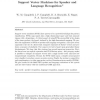2055 search results - page 23 / 411 » Nested support vector machines |
COLING
2002
13 years 10 months ago
2002
This paper proposes a learning and extracting method of word sequence correspondences from non-aligned parallel corpora with Support Vector Machines, which have high ability of th...
BMCBI
2008
13 years 10 months ago
2008
Background: Cancer diagnosis and clinical outcome prediction are among the most important emerging applications of gene expression microarray technology with several molecular sig...
BMCBI
2006
13 years 10 months ago
2006
Background: Multicategory Support Vector Machines (MC-SVM) are powerful classification systems with excellent performance in a variety of data classification problems. Since the p...
CSL
2006
Springer
13 years 10 months ago
2006
Springer
Support vector machines (SVMs) have proven to be a powerful technique for pattern classification. SVMs map inputs into a high dimensional space and then separate classes with a hy...
ML
2002
ACM
13 years 9 months ago
2002
ACM
Practical experience has shown that in order to obtain the best possible performance, prior knowledge about invariances of a classification problem at hand ought to be incorporated...

